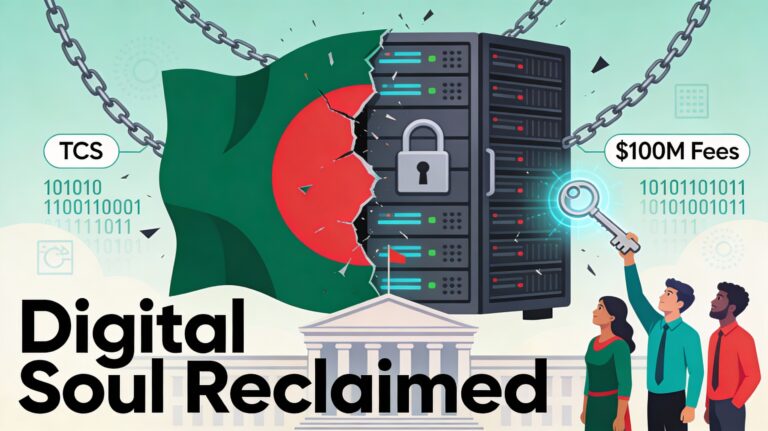
JLR Cyber Attack Fallout: How Tata Motors and TCS Face Billions in Revenue and Reputation Losses
A crippling cyber attack has paralyzed Jaguar Land Rover, costing Tata Motors ₹1,800–3,600 crore and shaking TCS’s cybersecurity credentials. With production halted until October 2025, supply chains falter, and festive sales hang in the balance. How did hackers breach JLR’s high-tech systems? Can Tata recover billions in losses? Discover the financial fallout, TCS’s reputation crisis, and urgent lessons for India Inc. to combat cyber threats in 2025.
The recent cyber attack on Jaguar Land Rover (JLR), a subsidiary of Tata Motors, has forced the automaker to extend its production pause till 1st October 2025. Industry insiders report that this downtime is costing JLR between £5–10 million (₹50–100 crore) each day, leading to projected losses of £150–300 million (₹1,800–3,600 crore) over 30 days. For Tata Motors, this could shave off ₹160–317 crore from profit before tax (PBT) in the current fiscal year and quarter. What makes matters worse is the ripple effect: the production halt is likely to disrupt supply chains into the next quarter, while Tata Consultancy Services (TCS), the IT arm responsible for JLR’s cybersecurity, faces damage to its brand image and client trust.
Why the JLR Cyber Attack Matters to India Inc.
Jaguar Land Rover, acquired by Tata Motors in 2008, accounts for nearly 65% of the company’s consolidated revenue, driven by high-demand luxury vehicles like Range Rover, Defender, and Discovery. A production standstill is not just a corporate hiccup—it’s a financial earthquake with ripple effects across the Tata Group and India’s automotive sector. Here’s why:
- Massive Revenue Hit: Daily losses of ₹60–120 crore could total ₹1,800–3,600 crore over 30 days.
- Profit Squeeze: Analysts estimate a ₹160–317 crore reduction in Tata Motors’ profit before tax (PBT) for FY26.
- Supply Chain Chaos: The halt disrupts JLR’s just-in-time supply chain, affecting suppliers in India, the UK, and beyond.
- Reputation at Stake: TCS, responsible for JLR’s cybersecurity, faces scrutiny over its ability to protect critical systems.
For Indian investors and businesses, this incident underscores the growing intersection of cybersecurity and financial stability, especially for conglomerates like Tata Group with global exposure.
Key Takeaways from the JLR Cyber Attack
- Revenue Loss: ₹1,800–3,600 crore projected due to JLR’s production pause until October 1, 2025.
- Profit Impact: Tata Motors faces a ₹160–317 crore PBT hit in FY26.
- Supply Chain Fallout: Delays may extend into Q3, impacting festive season sales in India and Europe.
- TCS Reputation: Cybersecurity lapses raise questions about TCS’s global IT leadership.
- Lesson for India: Cybersecurity is now a boardroom priority for operational resilience.
The Anatomy of the JLR Cyber Attack
The cyber attack, detected on September 1, 2025, crippled JLR’s IT infrastructure, forcing the company to shut down systems to contain the damage. While JLR has not disclosed full details, industry reports suggest a sophisticated attack, possibly involving:
- Ransomware: Likely targeting JLR’s production networks, halting assembly lines.
- Data Breaches: Potential leaks of employee, supplier, or proprietary product data.
- Supply Chain Vulnerability: Hackers may have exploited third-party access points, a common weak link.
The attack’s timing—coinciding with new UK registration plates on September 1—amplified its impact, disrupting sales during a peak period. JLR’s swift system shutdown minimized further damage but paralyzed operations across its UK, Slovakia, Brazil, and India plants, with only its Chinese joint venture reportedly unaffected.
How the Attack Unfolded
- Initial Breach: Detected on August 31, 2025, with hackers accessing JLR’s IT systems.
- System Shutdown: JLR took critical systems offline to prevent further infiltration.
- Production Halt: Factories in Halewood, Solihull, and Wolverhampton stopped, sending 33,000 workers home.
- Ongoing Investigation: JLR, with TCS and the UK’s National Cyber Security Centre (NCSC), is probing the breach, with no clear timeline for recovery.
The hacker group “Scattered Lapsus$ Hunters” claimed responsibility, posting screenshots of JLR’s internal systems on Telegram, hinting at a social-engineering campaign that exploited supplier or CRM vulnerabilities.
Financial Fallout for Tata Motors
Immediate Revenue Losses
JLR’s three UK factories produce about 1,000 vehicles daily, each contributing to high-margin sales. The production pause translates to:
- Daily Loss: £5–10 million (₹60–120 crore).
- 30-Day Total: £150–300 million (₹1,800–3,600 crore).
- Lost Output: Approximately 24,000 vehicles, with profits of £120 million (₹1,440 crore) wiped out.
These figures align with estimates from David Bailey, a professor at the University of Birmingham, who pegs JLR’s weekly revenue loss at £50 million (₹600 crore).
Profit Before Tax (PBT) Impact
Tata Motors’ FY26 earnings are under pressure:
- PBT Hit: ₹160–317 crore reduction, assuming partial cost recovery.
- Dealer Strain: Incentives to offset delayed deliveries add financial burden.
- Working Capital: Cash flow disruptions due to halted sales and supplier payments.
This comes at a challenging time, as JLR reported an 11% drop in quarterly sales in July 2025 and cut its FY26 profit margin target from 10% to 5–7% due to US tariffs.
Longer-Term Risks
- Supply Chain Overhang: Restarting complex automotive production takes weeks, with supplier bottlenecks likely extending into Q3.
- Market Share Erosion: Competitors like BMW and Audi could capture demand for luxury SUVs.
- Investor Sentiment: Tata Motors’ stock dipped 1% to ₹705 on September 16, reflecting market jitters.
For Indian investors, these losses signal volatility in Tata Motors’ stock, though analysts view the cyber attack as a one-off if recovery is swift.
TCS’s Cybersecurity Role Under Scrutiny
TCS, part of the Tata Group, signed a £800 million (₹8,400 crore) five-year contract in 2023 to manage JLR’s IT and cybersecurity. The attack has raised three critical questions:
- Breach Vulnerability: How did hackers penetrate JLR’s “smart factory” systems, celebrated for their connectivity?
- Recovery Delays: Why is system restoration taking weeks, delaying production until October 1?
- Brand Damage: If TCS fails to protect a sister company, can it reassure global clients?
TCS’s role in previous breaches at Marks & Spencer and Co-op, reportedly linked to the same Scattered Spider group, adds to the scrutiny. The company may need to invest heavily in AI-driven threat detection and zero trust architecture to restore confidence.
How Cyber Attacks Disrupt Auto Supply Chains
JLR’s reliance on just-in-time (JIT) manufacturing amplifies the attack’s impact:
- Production Lines: Software-driven robotics and scheduling systems require real-time IT coordination. A single breach halts assembly.
- Supplier Portals: Offline systems block parts orders, stranding suppliers in India, the UK, and Europe.
- Logistics: Global parts distribution, including from Indian vendors, grinds to a halt, delaying repairs and deliveries.
The fallout risks missing India’s festive season and Europe’s Christmas sales, critical for JLR’s high-margin models. Smaller suppliers, supporting 104,000 UK jobs, face financial strain, prompting calls for government aid.
Pro Tips for Indian Corporates on Cyber Risk in 2025
- Invest in Zero Trust Architecture: Traditional perimeter security is outdated. Hackers bypass entry firewalls easily.
- Adopt AI-Powered Threat Detection: Modern tools predict anomalies before breaches occur.
- Conduct Supplier Audits: Most vulnerabilities originate in third-party vendors.
- Speed of Recovery Is Critical: Even if prevention fails, fast restoration preserves trust.
- Board Accountability: Cybersecurity should not be left only to IT departments—it is a strategic revenue protector.
Common Cybersecurity Mistakes to Avoid
Indian companies often falter by:
- Underestimating Risks: Assuming only banks or tech firms are targets.
- Compliance Focus: Treating cybersecurity as a checklist rather than a dynamic process.
- Neglecting Recovery Drills: Failing to test production system backups.
- Ignoring OT-IT Segregation: Not isolating operational technology from general IT networks.
What This Means for Tata Investors
From an Indian capital market standpoint:
- Tata Motors' stock may see near-term negative sentiment, though analysts view cybersecurity shocks as one-off incidents if contained.
- TCS may face pressure from global clients demanding reassurance and independent audits.
- Tata Group’s overall brand, usually admired for trust and resilience, faces reputation questions when two of its crown jewels—Tata Motors and TCS—are seen as vulnerable.
Global Auto Industry Context
The JLR attack coincides with broader automotive challenges:
- EV Transition: JLR’s electrification plans, including a £4 billion UK gigafactory, need funding, strained by revenue losses.
- Chip Shortages: Cyber disruptions exacerbate existing supply constraints.
- Festive Demand: Missing peak sales seasons risks permanent customer loss to rivals.
For Indian industry, this highlights how global cyber risks impact local markets, especially for BSE-listed giants like Tata Motors.
Lessons for India Inc. from the JLR Attack
- Cybersecurity is not a back-office IT function—it is a boardroom priority.
- Multinationals with India presence must prepare for geopolitical cyber risks.
- Indian IT majors like TCS, Infosys, and Wipro will face greater scrutiny on client-facing cyber expertise.
- Investors in Indian companies must track supply chain cyber safeguards as a key valuation metric.
Final Thought: Beyond Recovery, Towards Resilience
The JLR cyber attack, its financial fallout for Tata Motors, and the reputational dent for TCS serve as a reminder of 2025’s corporate reality: digital infrastructure is as critical as physical plants. Whether it is a luxury SUV rolling off JLR’s UK plant or a line of code keeping systems safe, both are now intertwined.
For Tata Motors, the next few quarters will test its resilience in balancing lost revenues while keeping its EV goals on track. For TCS, every extra day of system downtime risks diluting its brand promise as a global IT leader.
Indian corporates and investors must treat this episode not just as a Tata setback but as a wake-up call. Cybersecurity has become the core driver of financial stability in the digital-first economy.
If large, respected giants like Tata Motors and TCS can be shaken, no company—from startups to conglomerates—is immune. The real question for India Inc. in 2025 is not if the next cyber attack will come, but how prepared will we be to withstand it.
Disclaimer: The use of any third-party business logos in this content is for informational purposes only and does not imply endorsement or affiliation. All logos are the property of their respective owners, and their use complies with fair use guidelines. For official information, refer to the respective company’s website.

































